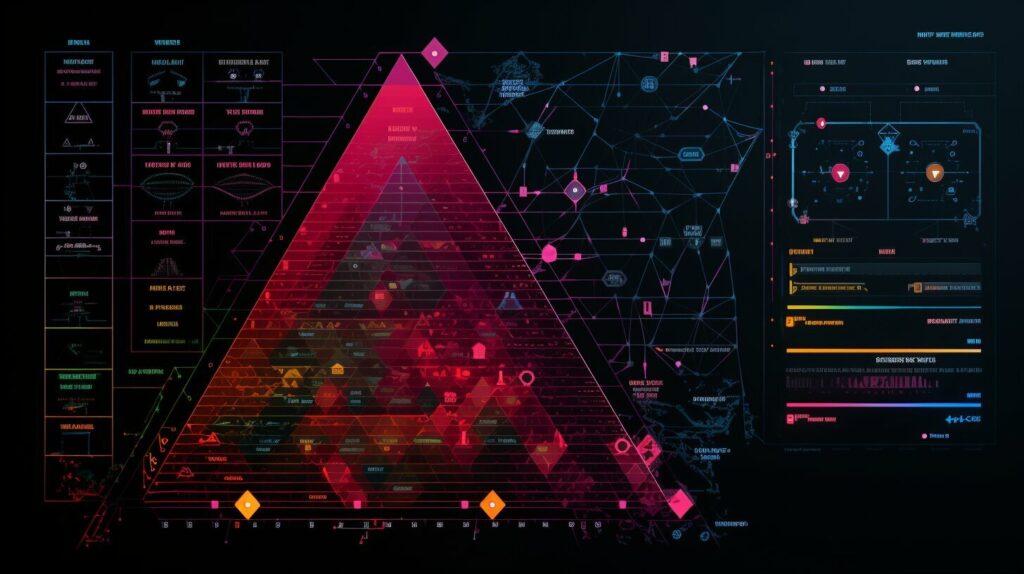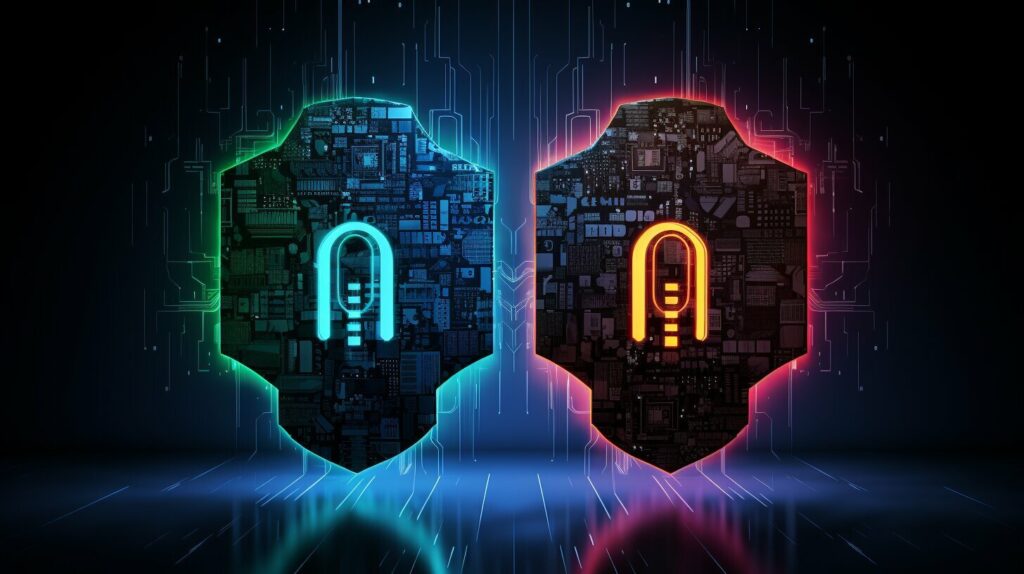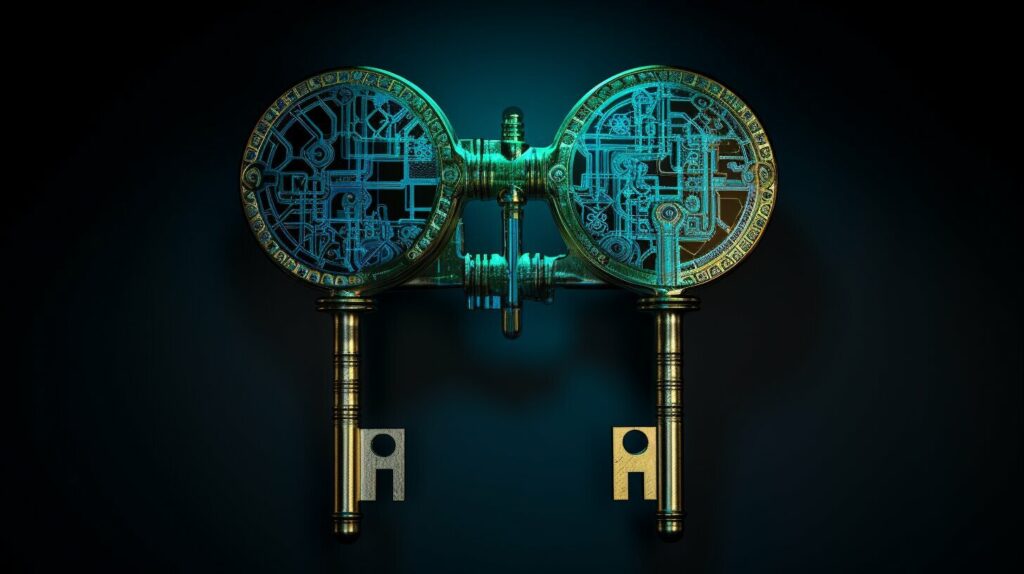In today’s digital age, secure communication over the internet has become a necessity. SSL/TLS (Secure Sockets Layer/Transport Layer Security) is a widely used protocol for securing online communication. Encryption algorithms play a crucial role in SSL/TLS, as they are responsible for generating secure cryptographic keys that ensure the confidentiality and integrity of data exchanged over the internet. Two commonly used encryption algorithms are RSA and ECC. Both algorithms have their strengths and weaknesses, and the choice between them depends on various factors.
Key Takeaways:
- SSL/TLS algorithms are crucial for securing online communication
- RSA and ECC are two commonly used encryption algorithms
- The choice between RSA and ECC depends on various factors
Understanding Encryption Algorithms
Encryption algorithms are essential tools for protecting digital information from unauthorized access. These algorithms use cryptographic keys to transform plaintext data into ciphertext, which can only be read by someone with the corresponding key. In other words, encryption algorithms ensure that sensitive information remains private and secure.
Cryptographic keys are an integral part of encryption algorithms. They are unique codes that allow users to encrypt and decrypt data. Public key cryptography, also known as asymmetric cryptography, is a popular encryption method that uses two different keys: a public key and a private key. The public key is available to anyone who wants to communicate with the key owner, while the private key is only known to the key owner.
The encryption process starts with the sender encrypting the data with the recipient’s public key. The recipient then uses their private key to decrypt the data. This process ensures that only the recipient can read the data, as they are the only ones with the private key. Asymmetric encryption algorithms are widely used in secure communication protocols, such as SSL/TLS.
Encryption algorithms play a crucial role in data security. However, not all encryption algorithms are created equal. Some are stronger and more secure than others. The two most popular encryption algorithms used in SSL/TLS are RSA and ECC. In the next sections, we will explore the differences between these two algorithms and their strengths and weaknesses in securing online communications.

RSA Encryption Algorithm
The RSA encryption algorithm is named after its creators, Ron Rivest, Adi Shamir, and Leonard Adleman, who first introduced it in 1977. It is a widely adopted public-key cryptography algorithm that uses two keys, a public key for encrypting data and a private key for decrypting it.
The RSA algorithm is based on the mathematical properties of large prime numbers and their factorization, making it secure against known attacks such as brute force and integer factorization. The security of RSA encryption depends on the length of the key, with longer keys providing greater security against attacks. The algorithm is commonly used in digital certificates and secure communication channels such as HTTPS.
The process of generating RSA key pairs involves selecting two large prime numbers and computing their product, known as the modulus. The modulus is used to generate the public and private keys, which are derived from mathematical operations on the prime factors of the modulus. RSA keys are typically generated using a secure random number generator to ensure their uniqueness and strength.

“The security of RSA encryption depends on the length of the key, with longer keys providing greater security against attacks.”
Despite its widespread adoption and proven security, RSA encryption has some drawbacks. As key size increases, so does the computational complexity of RSA encryption operations, making it less efficient than other algorithms such as ECC for certain applications. Additionally, the security of RSA encryption is threatened by the advent of quantum computing, which could potentially break RSA keys and compromise data encrypted using the algorithm.
Overall, RSA encryption remains a critical component of modern public key cryptography, providing a secure and widely recognized means of encrypting data and securing communication channels online.
ECC Encryption Algorithm
The ECC encryption algorithm is a type of public key cryptography that uses elliptic curves to encrypt and decrypt data. Unlike RSA, which is based on prime factorization, ECC relies on the difficulty of solving the discrete logarithm problem in finite fields.
ECC encryption offers several advantages over RSA, the most notable being its efficiency in both key size and computation. ECC keys are typically much smaller than RSA keys, allowing for faster key exchange and reduced resource usage. Additionally, ECC is well-suited for use in resource-constrained devices, making it an attractive option for securing the Internet of Things (IoT).
The strength of ECC encryption lies in its use of elliptic curve cryptography, which provides a higher level of security compared to traditional methods. The use of elliptic curves in ECC allows for a smaller key size while maintaining the same level of security as larger RSA keys.
Elliptic Curve Cryptography
Elliptic curve cryptography is a type of cryptography that is based on the mathematical properties of elliptic curves. These curves provide a way to perform mathematical operations that are useful for encryption and decryption.
The security of ECC encryption lies in the difficulty of solving the discrete logarithm problem in finite fields. This problem involves finding the logarithm of a specified number over a specified finite field. The difficulty of solving this problem increases as the size of the field increases, making it a suitable method for securing data.
ECC keys are generated using an elliptic curve and a starting point on that curve. The keys are then calculated using mathematical operations performed on the curve. These keys can be used for secure key exchange and data encryption.
| Advantages of ECC Encryption | Disadvantages of ECC Encryption |
|---|---|
| – Efficient in key size and computation | – Less widely adopted compared to RSA |
| – Suitable for use in resource-constrained devices | – Lack of standardized key formats |
| – Higher security level compared to RSA | – Requires more expertise to implement |
Strengths of RSA Encryption
Despite the growing popularity of ECC encryption, RSA remains one of the most widely used encryption algorithms in the industry. One key strength of RSA is its robustness. With larger key sizes, RSA can provide a high level of security against brute force attacks. RSA encryption is also highly versatile and can be used for a variety of applications, including email encryption, digital signatures, and SSL/TLS encryption for secure website communication.
Another advantage of RSA encryption is the well-established public key infrastructure (PKI) that supports it. PKI has been around since the 1980s and has played a significant role in establishing trust in online transactions. The widespread adoption of RSA encryption has contributed to the development and evolution of PKI, making it a reliable and effective system for secure communication.
Furthermore, RSA key pairs are generated through a well-understood and well-documented process. This makes it easier for developers to implement RSA encryption and ensures that the encryption keys are secure when generated correctly. With proper key size and secure key management practices, RSA can provide a high level of security for secure communication.
In summary, RSA encryption offers robustness, versatility, and well-established support through PKI. Proper key size and secure key generation practices can ensure a high level of security for online communication.
Strengths of ECC Encryption
Compared to RSA, ECC encryption offers significant advantages in certain areas. One of the key strengths of ECC is its efficiency in terms of key size. ECC keys are much smaller than RSA keys while providing equivalent security levels.
Moreover, ECC is highly suitable for resource-constrained devices due to its lower computational requirements. This makes it an attractive option for securing the Internet of Things (IoT) and emerging technologies that rely on low-power hardware.
At the heart of ECC’s strength is elliptic curve cryptography, which offers a more secure foundation for the algorithm. ECC keys are derived from points on an elliptic curve, which makes them more resistant to certain attacks compared to RSA keys.
| ECC Encryption Strengths | RSA Encryption Strengths |
|---|---|
| Efficient use of resources | Widespread adoption in industry |
| Resistant to certain attacks | Robustness |
| Smaller key size | Secure key generation process |
ECC’s strengths are particularly relevant in modern use cases where performance and efficiency are critical. Its adoption in protocols such as HTTPS highlights its increasing importance in securing online communications.

Performance Comparison: RSA vs ECC
When it comes to performance, RSA and ECC encryption algorithms have different strengths and weaknesses. The most notable differences lie in key size, computational efficiency, and resource requirements.
RSA encryption requires larger key sizes to provide adequate security compared to ECC. For example, a 3072-bit RSA key is equivalent in security to a 256-bit ECC key. This means that RSA encryption requires more computational power to generate keys and perform encryption and decryption operations. As a result, RSA is less efficient than ECC, especially when it comes to constrained devices with limited resources.
On the other hand, ECC uses smaller key sizes, making it more computationally efficient and requiring fewer resources than RSA. ECC can provide equivalent security with smaller key sizes compared to RSA. For instance, a 256-bit ECC key provides the same level of security as a 3072-bit RSA key. This makes ECC better suited for applications that require fast and efficient encryption, especially in mobile and Internet of Things (IoT) environments.
| Factor | RSA | ECC |
|---|---|---|
| Key sizes | Large | Small |
| Computational efficiency | Less efficient | More efficient |
| Resource requirements | More resources | Fewer resources |
However, the choice between RSA and ECC ultimately depends on the specific use case and security requirements. While RSA may be less efficient than ECC, it offers a higher level of security in some scenarios due to its longer key lengths. It’s also important to note that RSA is a more mature algorithm with wider adoption in the industry, making it a more reliable choice for some applications.
Therefore, it’s essential to consider multiple factors when deciding between RSA and ECC, including computational efficiency, resource requirements, security needs, device capabilities, and the potential need for backward compatibility.
Security Comparison: RSA vs ECC
While both RSA and ECC are widely used encryption algorithms, they have different strengths and weaknesses when it comes to security.
RSA encryption relies on the difficulty of factoring large numbers and is considered secure when using key sizes of 2048 bits or greater. However, as computing power continues to advance, the security of RSA is increasingly at risk. RSA keys are also vulnerable to attacks that exploit weaknesses in the implementation or key generation process.
On the other hand, ECC encryption is based on the difficulty of solving the elliptic curve discrete logarithm problem. ECC keys are shorter than RSA keys for the same level of security, making it more efficient for resource-constrained devices. ECC is also resistant to certain attacks that can compromise RSA keys.
Impact of Key Size
One of the primary factors affecting the security of both RSA and ECC is key size. As computing power continues to increase, longer key sizes must be used to maintain the same level of security. For RSA, a key size of 2048 bits is currently recommended, while for ECC, a key size of 256 bits is considered equivalent in strength.
It is important to note that increasing key size also impacts the computational requirements for encryption and decryption processes. As key size increases, so does the resource demand, making it important to balance security needs with operational constraints.
Public Key Cryptography Vulnerabilities
In addition to key size, it is important to consider vulnerabilities in the underlying public key cryptography used by both RSA and ECC. RSA is vulnerable to attacks that exploit weaknesses in the padding schemes used to ensure secure message transmission. Implementing proper padding schemes and key generation processes can help mitigate these risks.
Similarly, ECC is vulnerable to attacks that exploit weaknesses in the elliptic curve parameters used to generate keys. Ensuring that the parameters used are properly generated and implemented can help mitigate these risks.

Choosing the Right Algorithm
When selecting between RSA and ECC, it is important to consider the specific security needs and operational constraints of the use case. For resource-constrained devices, ECC may be the more appropriate choice, while RSA may be better-suited for use cases that require longer key sizes or widely adopted standards.
Ultimately, the security of both RSA and ECC relies on proper key generation and implementation processes. Choosing the appropriate algorithm and ensuring proper key management practices can help mitigate security risks and maintain secure communication.
Real-World Applications of RSA
RSA encryption is widely used in secure communication channels due to its robustness and efficiency. It is commonly employed to secure various online services such as email, web browsing, and online banking. One of the most popular applications of RSA is in the Transport Layer Security (TLS) protocol, which is used to establish secure connections between web servers and clients.
The RSA algorithm is particularly suited for digital signatures, where message authenticity and integrity are of critical importance. Many e-commerce websites use RSA to ensure that messages are not tampered with during transmission. RSA is also used in virtual private networks (VPNs) to secure data communication between remote locations.
Despite its widespread adoption, key management of RSA encryption can be challenging. As RSA keys are vulnerable to certain types of attacks, it is important to ensure that key pairs are generated securely and are periodically changed to maintain security. This requires careful planning and implementation of key management policies.

Real-World Applications of ECC
ECC encryption has become increasingly relevant in recent years due to its suitability for resource-constrained devices and emerging technologies. Its efficient use of computational resources makes it ideal for securing the Internet of Things (IoT) and other devices that have limited processing power.
One example of ECC’s adoption in security protocols can be seen in HTTPS, where Elliptic Curve Digital Signature Algorithm (ECDSA) is used to sign SSL/TLS certificates. This method is quickly becoming the preferred method of secure communication for websites due to its efficiency and robustness.
Another application of ECC can be seen in mobile devices, where the processing power and battery life are limited. ECC’s ability to provide strong security with smaller key sizes allows for faster processing and less battery usage, making it an ideal algorithm for mobile applications.
The adoption of ECC in these real-world applications highlights its relevance and effectiveness in securing online communication. As more devices and technologies emerge, it is likely that ECC will continue to play an increasingly important role in securing our digital lives.
Key Length Recommendations
When generating RSA or ECC keys, it’s important to consider key length and the level of security it provides. Currently, the recommended key length for RSA is 2048 bits, while the equivalent for ECC is a 256-bit curve. However, it’s worth noting that the same level of security can be achieved with shorter ECC keys, making it a more efficient option for resource-constrained devices.
The choice of key length should also take into account the potential for future advancements in computing power. As technology continues to advance, longer key lengths may be needed to maintain the same level of security. It’s also important to ensure secure key generation practices are followed, as weak keys can compromise the security of the encryption process.
According to the National Institute of Standards and Technology (NIST), it’s recommended to use key sizes that are at least 112 bits for RSA and 128 bits for ECC, which provide equivalent levels of security. NIST also advises against using key lengths below 2048 bits for RSA and 224 bits for ECC, as they may not provide sufficient security against future attacks.
Transitioning from RSA to ECC
Moving from RSA to ECC encryption requires careful planning and consideration to ensure a smooth transition. While ECC offers many advantages over RSA, the coexistence of both algorithms during the transition period can create some challenges.
One important consideration is backward compatibility. Applications that use RSA encryption may not be able to communicate with those that use ECC encryption. To avoid any disruptions, it is crucial to have a plan in place for backward compatibility during the transition period.
Another challenge is the need for secure key exchange between RSA and ECC systems. The two algorithms use different key formats, and it is important to ensure that the keys are securely generated and exchanged.
It is also essential to consider the performance requirements of the applications during the transition. ECC encryption is more efficient than RSA, but it may not always be the best choice depending on the specific use case. Consider the computational resources available and the security requirements when choosing between the two algorithms.
Ultimately, transitioning to ECC encryption can bring significant benefits in terms of security and efficiency. However, it requires careful planning and consideration to ensure a smooth and secure transition.
Factors Influencing Algorithm Selection
Choosing the appropriate encryption algorithm is crucial to ensure secure communication in different scenarios. When deciding between RSA and ECC, various factors come into play, such as:
- Computational resources available
- Security requirements
- Device capabilities
The choice of algorithm depends on the specific context and the trade-offs between speed and security. For instance, RSA may be a better choice for high-security applications that require longer key lengths and more computational resources, while ECC may be suitable for resource-constrained devices and low-power environments where speed is essential.
Moreover, the adoption of new cryptographic standards and protocols should also be considered when selecting an algorithm. The National Institute of Standards and Technology (NIST) recommends transitioning to ECC to enhance security and support future advancements in post-quantum cryptography.
Ultimately, the selection of RSA or ECC should be based on a thorough evaluation of the specific use case and a consideration of the current and future security needs of the communication system.

Future Trends in SSL/TLS Algorithms
As technology continues to advance, the need for stronger and more secure encryption algorithms is becoming increasingly important. One such advancement that could potentially have an impact on SSL/TLS algorithms is the development of quantum computing.
Quantum computers are able to solve complex problems at a faster rate than traditional computers, making them a potential threat to current encryption algorithms such as RSA and ECC. To combat this threat, researchers are exploring post-quantum cryptography which involves using mathematical problems that are difficult for both traditional and quantum computers to solve.
In addition to post-quantum cryptography, there is also ongoing research into improving the efficiency of existing algorithms. This includes developing new approaches to key exchange and signature schemes that reduce the computational resources required for secure communication.
Another trend is the adoption of hybrid encryption schemes that combine the strengths of multiple algorithms to enhance security. For example, a hybrid scheme could use RSA for key exchange and ECC for data encryption, providing a balance of performance and security.
Overall, the future of SSL/TLS algorithms is likely to involve a combination of post-quantum cryptography, algorithmic improvements, and hybrid schemes. As security threats continue to evolve, so too must the encryption algorithms and techniques used to protect online communication.
Conclusion
After a thorough comparison of RSA and ECC algorithms, it is evident that both have their strengths and weaknesses. RSA encryption is widely adopted and robust, but its security may be compromised with increasing computational power. On the other hand, ECC encryption is efficient and suitable for constrained devices, but its adoption is still limited.
Choosing the Appropriate Algorithm
When selecting the appropriate algorithm, it is important to consider factors such as computational resources, security requirements, and device capabilities. For example, RSA may be more suitable for desktop or server environments with higher computational resources, while ECC may be more appropriate for IoT devices with limited resources.
Future Trends
As advancements in quantum computing continue, the need for post-quantum cryptography becomes more urgent. Potential alternatives to RSA and ECC include lattice-based and code-based cryptography. It is essential to stay informed of these developments and consider their implications for secure communication.
In conclusion, the choice between RSA and ECC encryption algorithms depends on various factors, including security requirements and device capabilities. It is important to stay informed of the ongoing advancements in SSL/TLS algorithms and select the appropriate algorithm based on specific use cases and future considerations.
FAQ
Q: What are the differences between ECC and RSA encryption algorithms?
A: ECC and RSA are two different encryption algorithms used in SSL/TLS for securing online communications. ECC stands for elliptic curve cryptography, while RSA stands for Rivest-Shamir-Adleman. ECC uses elliptic curves in its cryptographic operations, while RSA relies on the difficulty of factoring large prime numbers.
Q: What is the role of encryption algorithms in securing data?
A: Encryption algorithms are mathematical formulas used to scramble data and make it unreadable to unauthorized parties. They play a crucial role in securing sensitive information during transmission and storage.
Q: How does the RSA encryption algorithm work?
A: RSA encryption works by utilizing the mathematical properties of large prime numbers. It involves generating a pair of RSA keys, one public key for encryption and one private key for decryption. Data encrypted with the public key can only be decrypted using the corresponding private key.
Q: What is the ECC encryption algorithm?
A: The ECC encryption algorithm is based on the mathematical principles of elliptic curve cryptography. It offers a more efficient and secure approach to encryption compared to RSA. ECC uses elliptic curve points and operations to generate the encryption keys.
Q: What are the strengths of RSA encryption?
A: RSA encryption is known for its robustness and widespread adoption in the industry. It offers strong security when used with sufficiently large key sizes. The key generation process for RSA is also well-established and widely supported by cryptographic libraries.
Q: What are the strengths of ECC encryption?
A: ECC encryption offers several strengths compared to RSA. It is more efficient in terms of computational resources, making it suitable for resource-constrained devices. ECC also provides strong security with shorter key lengths, reducing the computational burden for key generation and exchange.
Q: How do RSA and ECC encryption algorithms compare in terms of performance?
A: The performance of RSA and ECC algorithms depends on factors such as key size and computational efficiency. RSA typically requires larger key sizes for comparable security, resulting in slower encryption and decryption processes. ECC, on the other hand, can achieve the same level of security with shorter key lengths, leading to faster cryptographic operations.
Q: What are the security considerations when comparing RSA and ECC?
A: RSA has been widely studied and implemented, but it is vulnerable to attacks based on advancements in computational power. ECC, with its reliance on elliptic curve mathematics, offers resistance against certain attacks. However, the overall security of both algorithms depends on appropriate key length selection and secure key management.
Q: Where is RSA encryption commonly used in real-world applications?
A: RSA encryption is commonly used in securing various communication channels, such as email encryption, web browsing (HTTPS), and online banking. Its widespread adoption and robustness make it a trusted choice for secure communication.
Q: What are the real-world applications of ECC encryption?
A: ECC encryption is particularly suitable for resource-constrained devices and emerging technologies. It is commonly used in protocols like HTTPS, securing communication in the Internet of Things (IoT) ecosystem, and other scenarios where efficiency and security are important.
Q: What are the recommended key lengths for RSA and ECC?
A: The recommended key lengths for RSA and ECC depend on the desired level of security and the current threat landscape. Generally, RSA key lengths of 2048 bits or higher are considered secure for the foreseeable future. For ECC, key lengths of 256 bits or higher are usually recommended for equivalent security.
Q: How can one transition from RSA to ECC encryption?
A: Transitioning from RSA to ECC encryption involves updating key exchange protocols and ensuring backward compatibility. Considerations include migrating existing RSA keys to ECC keys, supporting both algorithms during the transition period, and updating cryptographic libraries and protocols to support ECC encryption.
Q: What factors influence the selection of RSA or ECC algorithms?
A: The selection of RSA or ECC algorithms depends on factors such as available computational resources, security requirements, and device capabilities. RSA is a more established algorithm with wider adoption, while ECC offers advantages in terms of computational efficiency and suitability for constrained devices.
Q: What are the future trends in SSL/TLS algorithms?
A: Future trends in SSL/TLS algorithms consider advancements in quantum computing and the need for post-quantum cryptography. Researchers are exploring alternative encryption algorithms to replace RSA and ECC that offer resistance against quantum attacks while maintaining secure communication.





